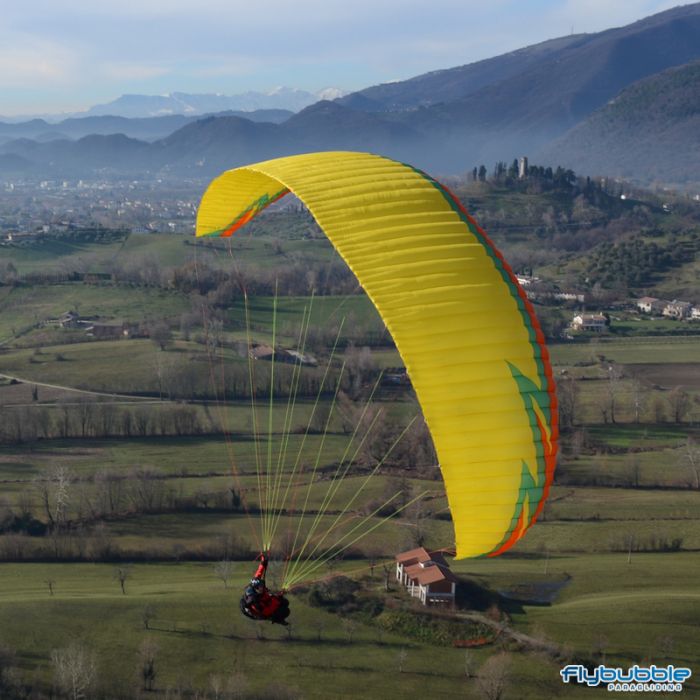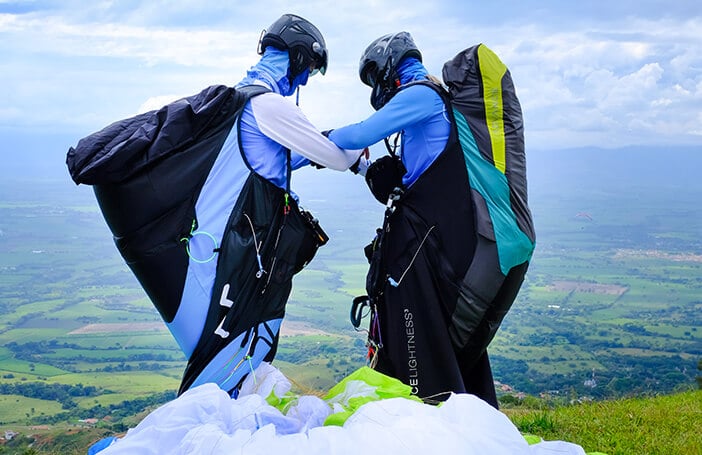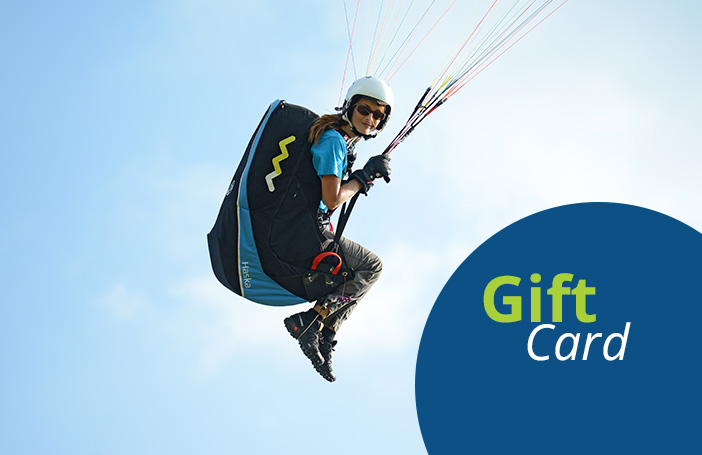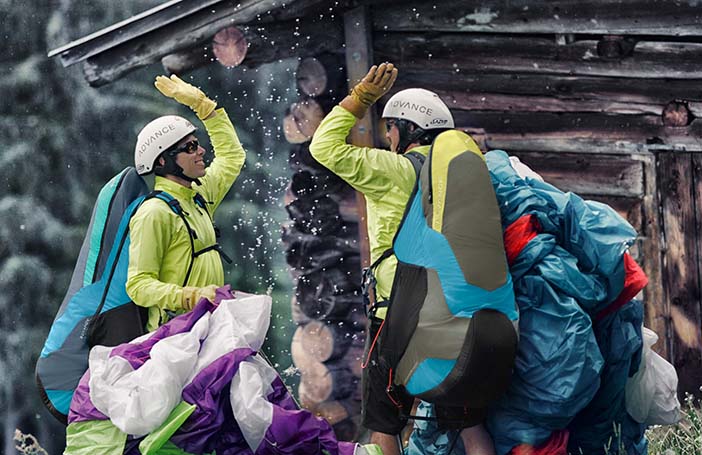Development and design
"Revolution through evolution": That's how the development process of the Mentor 3 can be summarized.
The Mentor 2 was our foundation for the Mentor 3: We wanted to refine and improve its well proven characteristics.
The first prototypes showed the huge potential for performance-improvements in seemingly small details. That's why it wasn't necessary to change the basic design of the Mentor 2.
Therefore, the Mentor 3 is the result of several well-conceived optimisation measures. The technical basic data stayed almost the same. But the leap in performance is the biggest we ever achieved from one model generation to the next.
Flying the Mentor 3
Mentor 2 pilots will immediately feel familiar with its successor: The Mentor 3 offers the same level of stability, compactness and precision.
The brake pressure got smaller and the cornering ability has improved. The Mentor 3 can be piloted more relaxed and even more efficiently in thermals than its predecessor. The feedback the pilot receives is softer, yet very precise.
The outstanding stability across the entire speed range stayed the same, just with a significantly better glide ratio and with a slightly improved top-end speed.
Safety
The results of our extensive test-flights with the Mentor 2 in turbulent air were confirmed: After more than two years, almost 3000 wings and many thousand hours in various conditions, the Mentor 2 has established itself as a very stable and reliable glider.
The DHV also confirmed, that the statistical accident analysis shows a very small number of Mentor 2 incidents, based on the number of sold gliders.
One reason for the high level of safety is the very small aspect ratio. This leads to an easy handling behaviour as well as to a considerable safety advantage in the case of a big collapse: The gliders' reaction is more manageable and the risk of a cravat is reduced.
The basic design (planform, aspect ratio, curvature, aerofoil, ...) wasn't changed on the Mentor 3. Accordingly, our tests in bumpy air showed the same stability and even slightly more damping of turbulences. We are confident, that the Mentor 3 will continue the legacy of the Mentor 2 as a safe and predictable high-level B glider.
Performance
The sheer glide performance of a glider is important. But what really matters is the usability of the performance potential in practical conditions.
Pilots need a wing, they can rely on. They need a very stable wing as well as a comfortable level of damping. This finally leads to the "overall performance" which made the Mentor 2 so successful.
The Mentor 3 doesn't just have a better glide ratio. (increased by 0.6 across the whole speed range) We also managed to relieve the pilot with a better handling behaviour and with a slightly higher level of damping. We think that this makes it even easier to use the gliders high performance.
Technical changes compared to Mentor 2
- 3D Shaping: We didn't invent it, but it's the first time you see this technique on a Nova wing. The 3D Shaping technique helps to achieve a cleaner leading edge by connecting several convex fabric pieces on the gliders nose.
- Optimized stabilo: The shape of the stabilo is crucial for a gliders performance. We did some small changes which significantly reduced the drag.
- New shape of the leading edge and the of the intakes: The design of the intake determines the internal pressure, which is decisive for a gliders characteristics. (for example for the stability) We tried many different shapes (first in computer simulation, then in flight tests) until we were finally able to improve this part of the wing as well.
- New brake geometry and reefing system: We could reduce the line length and at the same time improve the handling characteristics.
Pilot's Profile
To describe the pilots' demands we deliberately avoid statements, like: "You need at least 50 hours and 80 flights to fly the Mentor 3." Instead, we simply want to list some points, which are worth considering, if you think about getting a Mentor 3:
If you want to be able to enjoy the full performance potential of the Mentor 3, you need to master certain basic flying techniques.
This applies to all stages of the flight:
At launch, the Mentor 3 rises quicker above the pilot than a lower rated wing. This enables comfortable take-offs on tiny spots, but it requires a better timing on the brakes to prevent the wing from overshooting.
If you fly in turbulent conditions, your corrections on the brake have to be more accurate and faster than with an Ion 2 or Prion 2.
The landing can be more demanding as well, if you want to land on a tiny spot in turbulent air.
And last but not least, the Mentor 3 pilot has to react quicker and more accurate after big collapses, to avoid too much loss of height.
In this context we recommend to join a SIV with your new glider to get a better understanding of the gliders reactions if something goes wrong.
Paragliding is a sport which needs constant training. That's why we also recommend to spend some time on a training hill or just on a flat field to work on your ground handling.
This gives you the possibility to improve your launch technique a lot in just a couple of hours.
Please consider these thoughts and feel free to contact us for further questions.
Technical Data - Mentor 3
|
|
Type
|
-
|
XXS
|
XS
|
S
|
M
|
L
|
|
Zoom factor
|
-
|
0.880
|
0.930
|
0.970
|
1.010
|
1.050
|
|
No of cells
|
-
|
51
|
51
|
51
|
51
|
51
|
|
Projected wingspan
|
m
|
8.46
|
8.90
|
9.32
|
9.72
|
10.11
|
|
Projected surface area
|
m²
|
18.36
|
20.33
|
22.30
|
24.26
|
26.21
|
|
Projected aspect ratio
|
-
|
3.90
|
3.90
|
3.90
|
3.90
|
3.90
|
|
Flat wingspan
|
m
|
10.86
|
11.42
|
11.96
|
12.48
|
12.97
|
|
Flat surface area
|
m²
|
21.68
|
24.00
|
26.33
|
28.65
|
30.96
|
|
Flat aspect ratio
|
-
|
5.43
|
5.43
|
5.43
|
5.43
|
5.43
|
|
Line diameter
|
mm
|
0.6 / 0.7 / 0.8 / 1.3
|
0.6 / 0.7 / 0.8 / 1.3
|
0.6 / 0.7 / 0.8 / 1.3
|
0.6 / 0.7 / 0.8 / 1.3
|
0.6 / 0.7 / 0.8 / 1.3
|
|
Line length
|
m
|
6.27
|
6.60
|
6.91
|
7.21
|
7.49
|
|
Line consumption
|
m
|
216
|
227
|
238
|
249
|
259
|
|
max. profile depth
|
m
|
2.49
|
2.60
|
2.72
|
2.84
|
2.95
|
|
min. profile depth
|
m
|
0.62
|
0.65
|
0.68
|
0.71
|
0.74
|
|
Weight
|
kg
|
5.1
|
5.3
|
5.6
|
5.9
|
6.2
|
|
Legal take-off weight
|
kg
|
60-80
|
70-90
|
80-100
|
90-110
|
100-130
|
|
take-off weight motor
|
kg
|
|
|
|
|
|
|
Places
|
-
|
1
|
1
|
1
|
1
|
1
|
|
Certification
|
-
|
B
|
B
|
B
|
B
|
B
|
Colours
Standard Colours: Red Ice; Sundance; Green Dragon; Blue Lagoon.
Custom Colours: Extra cost. Delivery approx 10 weeks. Choose your colours here then email us the NOVA colour code with your order.
Downloads

![]()





